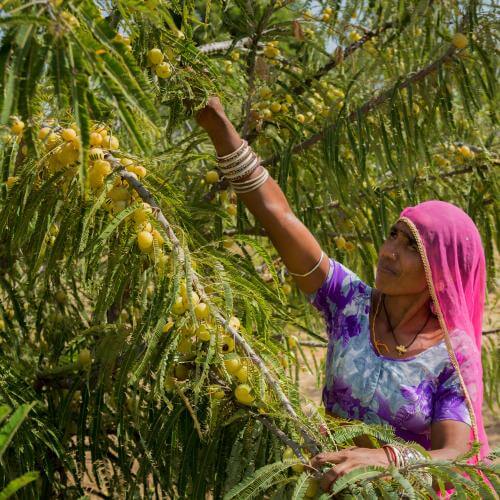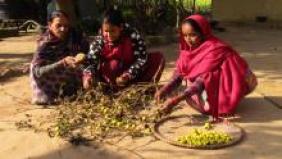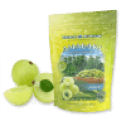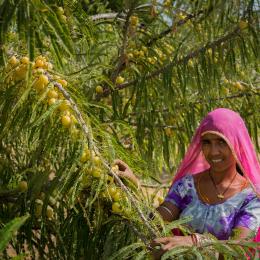
Have you heard of Amla? In fact, this tiny Indian fruit is a great treasure of Ayurvedic medicine that has been used for over 2500 years.
Its high amount of antioxidants and vitamin C helps cleanse the body of free radicals, strongly stimulates the immune system and nourishes body tissues. You can learn more about this herb in our article Amla - heavenly fruit of India
We would like to guide you here on how to effectively benefit from this traditional Ayurvedic fruit. We have been processing Amla in our manual herbal factory for 15 years and we offer it to you in several variants.
User Guide to Amla
Amla is an excellent dietary supplement either as a dried fruit as a traditional Ayurvedic ready-to-eat fruit or boiled in an Ayurvedic elixir, and also as a pure ground powder of RAW quality that can be used as Ayurvedic tea, hot amla with honey or with mixed fresh fruits as an Ayurvedic smoothie. It is up to you what you choose. We will go through all the options step by step.
AMLA as:
- Traditional dried fruit (prevention & immunity)
- Ayurvedic elixir (regeneration & vitality)
- Ayurvedic tea (for health problems)
Amla as a Dried Fruit - Excellent Prevention
You can try the fresh amla fruit, but few people are able to eat it whole, although its size resembles a larger gooseberry. Due to the high content of vitamin C is very sour and astringent. However, it also contains a bitter, pungent and sweet taste, so it has 5 out of 6 flavors that our senses can recognize. From an Ayurvedic point of view, this makes it an excellent preparation to balance all three biological energies of vata, pitta and kapha, whose individual ratio can be regulated by a respective diet with the right tastes.
Amla is therefore always found in a sweetened form, which is delicious. What matters is whether it is harvested in a sustainable manner in a natural environment without chemical pollution and in a ripe state, how it is dried and what sweetener is used.
Amla natural, along with other variants that we offer, comes from natural hand collection. Small farmers, whose only livelihood is often manual collection of herbs and fruits, harvest amla fruit from trees in the regions where they grow naturally, often in the forests around their places of residence. After collecting them, they spread them on the flat roofs of their houses, where they dry naturally in the sun and then get rid of the seeds. They sell a portion of their harvest directly to our herbal production in Kathmandu, where we use this amla to make Ayurvedic teas. 
Interesting facts:
In some areas, the amla is also harvested by indigenous tribes, such as the Soliga tribe, one of India's oldest tribes, who feed on the harvest of forest fruits in southern Karnataka in the Biligiri Rangaswamy Reserve. Their traditional dwellings are located high in treetops to protect themselves from wild beasts, which is why they are called tree people.
If amla is intended for a direct consumption as a dried fruit (Amla natural 100g), the procedure is little different – fresh fruit is pitted and cut into natural marigolds. Those are dipped in cane juice (fresh squeezed juice from long sugar cane leaves, which Indian children like to suck). Before being placed on the drying trays, they are rinsed several times with clean water to reduce the amount of cane juice to a minimum. Then they are dried in dryers by using solar energy up to a maximum temperature of 40 °C. This creates a treat, which is a popular vitamin supplement for children and adults. 
TIP: in regular daily regime as a disease prevention, we recommend 3 pieces (marigolds) a day.
Amla - Important Ingredient of Ayurvedic Prescriprions
If we want to follow the traditional way of using amla as part of Ayurvedic healing procedures, we will consume it in the form of so-called avalehas - herbal jams or elixirs, or as healing teas / beverages.
Avalehas - Ayurvedic Herbal Elixirs from Amla
In this case, amla fruit is actually cooked, as is the fruit from which marmalade is commonly made. This creates a jam into which Ayurvedic herbs are mixed in various stages. For some elixirs roots are used (e.g ginger, ashwagandha - Indian ginseng, turmeric, licorice, ...), for some fruits (cardamom, canopy, peppercorn, coriander, ..), for others stems, leaves or bark (guduchi, cinnamon, asparagus, sandalwood, brahmi, ..). Next, clarified butter (ghee) and honey are added.
Did you know that:
Amla has a very exceptional so-called retention ability - in every situation it tries to maintain the maximum amount of nutrients, and therefore also vitamin C. In practice, this means that it can be cooked for up to 8 minutes while maintaining 95% of its vitamins. Therefore, do not be afraid to boil Ayurvedic tea properly (we recommend 3-5 min). Even amla in Ayurvedic elixirs, where all the ingredients must be cooked together, is not impoverished.
Ayurvedic Teas with Amla
The last and most traditional way to take amla, is in Ayurvedic tea. Out of our list of 57 variants of herbal mixtures that we mix by hand, 24 of them contain amla (emblica officinalis. The most famous Ayurvedic combination is Triphala, where we combine the effects of three fruits – amla (emblica officinalis) together with fruits from trees bibhitaki (terminalia bellirica) and haritaki (terminalia chebula). This combination, which strongly detoxifies the intestinal tract, is usually very bitter and is most often sold in capsules. We rather recommend fluids that the body absorbs faster and better, which is why we offer triphala in the form of an Ayurvedic tea together with herbs that reduce its bitterness and therefore tastes pleasantly. 
Have you already decided which of the ways suits you best? Here is a brief health benefit of amla:
Body Detox - Immunity Boosting - Nutrition and Cell Regeneration
Amla acts as an excellent tonic for optimal functioning of immunity, digestion, metabolism, liver, blood, heart, brain activity and nervous system. Climbers, who know it, take it to higher altitudes, where they need to settle a sensitive stomach and support blood formation and tissue oxygenation. It accelerates the regeneration of the body during high energy expenditure and workload, but it is also a natural vitamin C supplement for children.
In Amla you will find:
-
a wide range of antioxidants (substances that reduce the normal oxidation process, which is responsible for aging and cell loss)
-
vitamins C, B1 and B2
-
bioflavonoids (vitamins supporting the resistance of cell walls against the penetration of free radicals)
-
a strong concentration of vital essential amino acids
-
minerals such as calcium, iron and phosphorus

